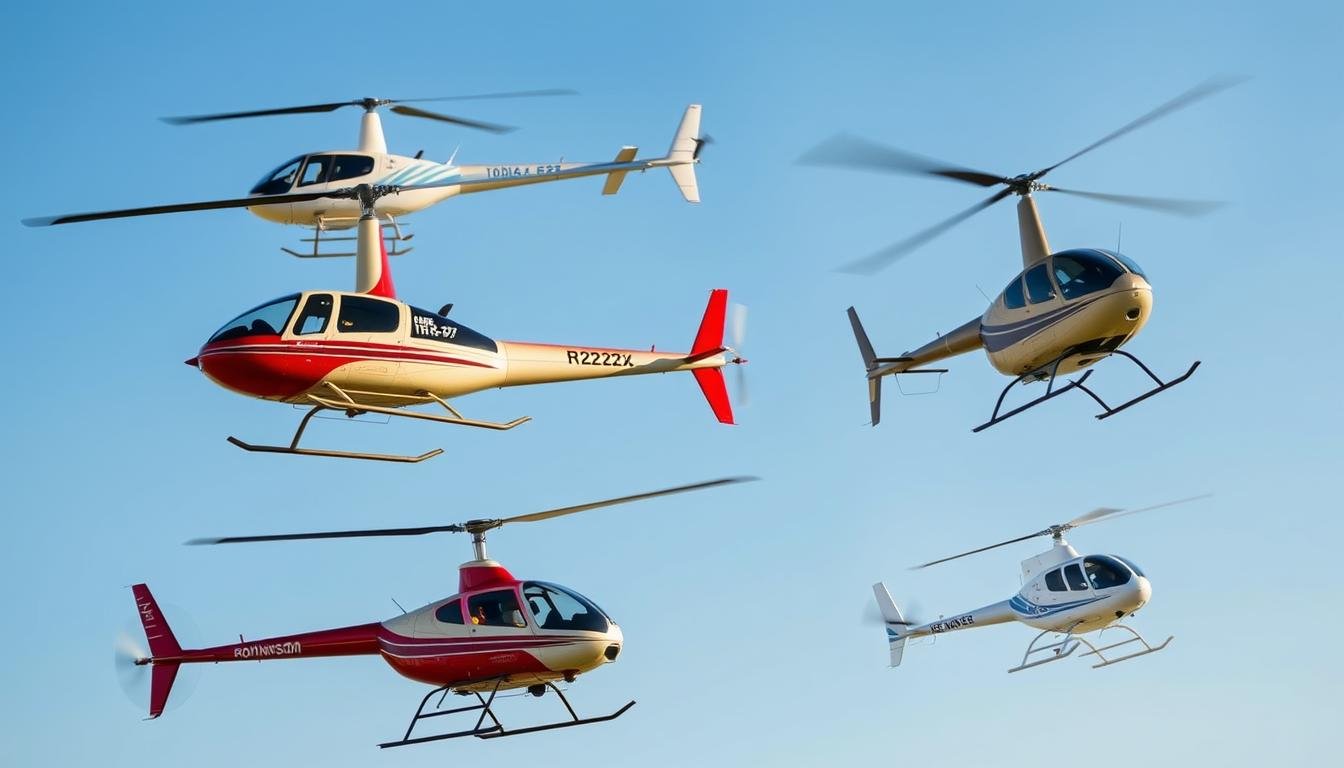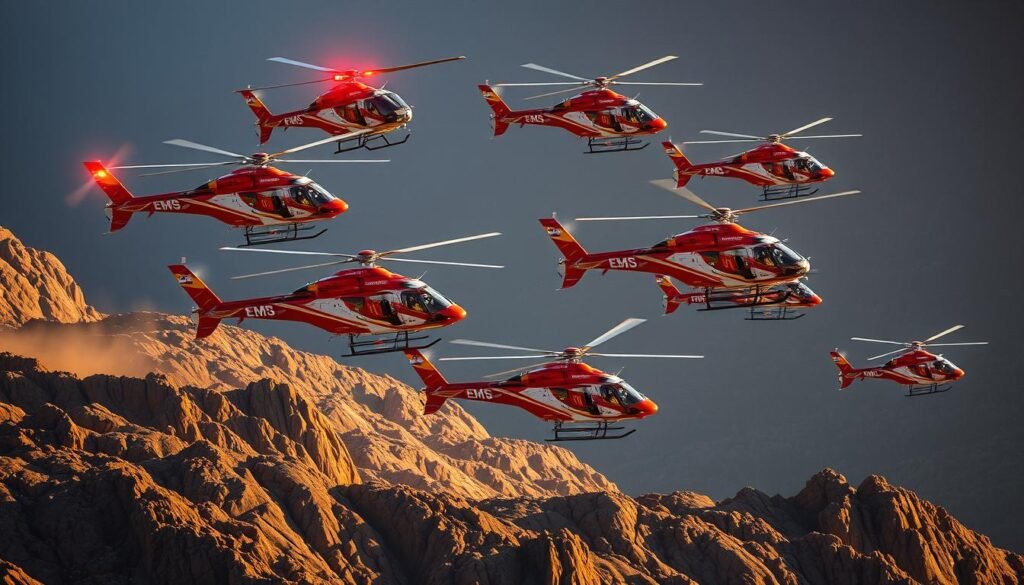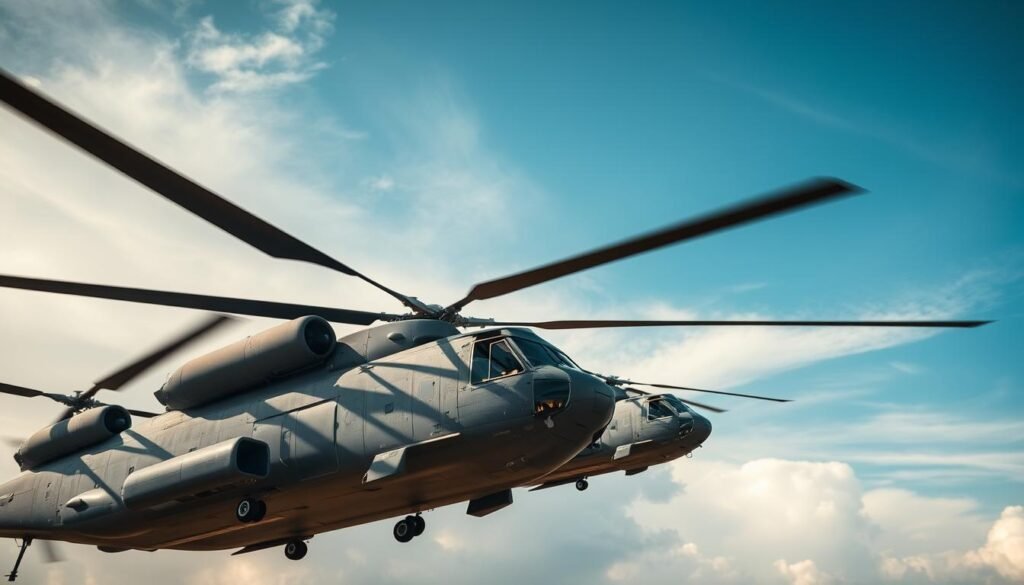Best Trainer Helicopters for Learning to Fly: Top Models for Student Pilots
Which model truly shapes a safer, faster path from first lesson to commercial readiness? This question frames every choice a student makes in aviation school.
Their selection balances cost, safety, and real-world readiness so new pilots move through flight milestones without delays. The Bell 505 stands out for its forgiving rotor system, predictable handling, and an idle/fly switch that simplifies emergency procedures.
The Leonardo TH-119 (TH-73A) supports a full spectrum of training with integrated ground systems, and a major U.S. Navy contract boosted deliveries through 2024. Civilian favorites include the Robinson R22 and R44, Schweizer 269/300, and the modern Guimbal Cabri G2.
This short review explains how each design and handling trait affects training pace and instructor workload. It also shows how simulation links to aircraft choices to build safer habits early and compress the learning curve.
For practical guidance, readers can compare models by cost, maintenance approach such as MSG-3, and availability at American aviation schools via this detailed guide: trainer helicopter model reviews.
Key Takeaways
- Choice affects how quickly a student achieves flight milestones and confidence.
- Bell 505’s forgiving design reduces instructor workload and improves safety practice.
- TH-119/TH-73A offers integrated simulation support for full-spectrum training.
- R22 and R44 remain cost-effective civilian options with different stability and costs.
- Design, maintenance methodology, and availability matter more than brand alone.
Trainer Helicopters Overview: What Student Pilots Need Right Now
“The right machine lets a novice convert hours into reliable flight skills faster.”
Student pilots need an aircraft that speeds learning without sacrificing safety. The Bell 505 is notable for simplified systems and a forgiving flight envelope that helps reduce early-stage mistakes.
The Leonardo TH-119/TH-73A supports single-configuration operations and pairs with ground based training systems to reinforce procedures before students enter the cockpit.
Common civilian models — the R22, R44, 269/300, and Cabri G2 — offer distinct cost and handling profiles. Schools pick platforms that match local operations, weather windows, and pattern work needs.
- Consistent performance cuts schedule delays and builds confidence.
- Integrated avionics prepare learners for modern flight without overwhelming them.
- Maintenance support and parts pipelines keep programs running on time.
“Programs that favor predictable handling let instructors spend more time coaching, not correcting.”
Choosing a machine that supports growth—from basic pattern work to autorotations—compresses timelines and standardizes curricula for better outcomes.
How To Choose a Training Platform: Safety, Systems, and Support
Picking the right training platform begins with clear, measurable criteria tied to safety and syllabus goals. These criteria guide selection so programs match mission needs and avoid needless complexity.
Safety Margins, Flight Envelope, And Main Rotor Design
Evaluate safety margins by checking flight envelope limits and how the main rotor affects stability. Model-specific design choices matter.
The Bell 505’s forgiving rotor system extends reaction windows during engine events. The Cabri G2 uses a three-bladed semi-articulated main rotor and a shrouded tail for added stability.
Avionics, Controls, And Emergency Procedures Integration
Prefer control layouts that simplify emergency drills so instructors can trigger realistic scenarios without warning. Look for avionics that build transferable skills while staying digestible for early-stage training.
“Systems that let instructors set up unrehearsed failures improve real-world readiness.”
Maintenance, Parts Availability, And Total Program Costs
Compare maintenance philosophies. Methods like MSG-3 reduce scheduled work and increase aircraft uptime. Assess parts networks and insurance to avoid calendar and budget surprises.

| Model Feature | Benefit | Program Impact |
|---|---|---|
| Forgiving Rotor (Bell 505) | Longer reaction window | Lower instructor correction time |
| GBS Integration (TH-119) | Ground rehearsal of procedures | Faster syllabus progression |
| MSG-3 Maintenance | Reduced scheduled inspections | Higher aircraft availability |
Match capability to the school’s mission so the chosen aircraft supports syllabus depth without adding needless cost.
Bell 505 Review: Forgiving Design, Modern Systems, Real-World Readiness
The Bell 505 pairs classroom-ready systems with flight characteristics that favor steady progress for early students. It balances crisp responsiveness with stable attitudes so novices learn control without undue penalty.

Flight Characteristics: Responsiveness, Stability, And Autorotation Practice
Handling is both responsive and predictable. Students feel clear control input, which makes practice more efficient.
The forgiving rotor extends reaction windows during engine-out drills. That helps learners build core skills and confidence in autorotation practice.
Safety And Systems: Idle/Fly Switch, Emergency Scenarios, Instructor Workload
The idle/fly switch lets instructors initiate realistic emergency scenarios cleanly. This reduces instructor workload while keeping exercises authentic.
The cockpit uses modern but approachable systems, so crews train on relevant avionics without unnecessary complexity.
Operating Costs, MSG-3 Maintenance Philosophy, And Aircraft Availability
Its fuel-efficient powerplant and an MSG-3 maintenance approach lower operating costs. Fewer scheduled tasks mean higher day-to-day availability for schools.
Decision point: Buyers seeking steady throughput should weigh acquisition cost against reduced downtime and lower per-hour expenses. Bell’s collaboration with training organizations helps tailor support to fleet size and scheduling needs.
- Practical result: Faster syllabus progression and more productive flight hours.
- Economic result: Lower lifecycle cost from efficient engines and MSG-3 maintenance.
Leonardo TH-119/TH-73A Review: Full Spectrum Training Made in the USA
The TH-119/TH-73A is built in Philadelphia at Leonardo’s AW119 Center of Excellence. It was designed to pair a single-configuration fleet with integrated Ground Based Training Systems to create consistent outcomes across classes.

Ground Based Training Systems And Single-Configuration Operations
Single-configuration operations simplify logistics and reduce variation between aircraft in a program. Schools benefit from predictable maintenance and easier parts management.
Integrated ground devices reproduce cockpit procedures so device sessions translate directly into in-flight performance. That integration speeds syllabus progression and reduces redundant instructor time.
U.S. Navy AHTS Adoption And Transition Capabilities
On January 13, 2020, the U.S. Navy awarded a contract for up to 130 TH-73A aircraft, with deliveries through 2024. That selection validates the platform’s full-spectrum capabilities and long-term supportability.
Pilot reports note excellent controllability and strong safety margins. The Genesys EFIS provides a modern instrument environment that eases the transition from basic maneuvers to advanced profiles.
- Built in the USA: Simplifies procurement and maintenance alignment for public and commercial programs.
- Integration: Ground systems and aircraft avionics improve learning transfer.
- Transition: Capabilities support smooth progression from primary training to advanced flight tasks.
“The platform’s controllability and support infrastructure make it a predictable choice for high-sortie training programs.”
Civilian Training Helicopters Compared: R22, R44, Schweizer 269/300, Cabri G2
Different civil models offer distinct trade-offs in stability, cabin space and hourly operating cost.

Robinson R22: Affordability, T-Bar Cyclic, SFAR 73 Considerations
The R22 is the budget leader for many flight schools. It has a T-bar cyclic and strict weight limits that affect pilot seating and payload.
Note: SFAR 73 requires 50 hours in type and 200 total helicopter hours to instruct, which shapes long-term pilot plans.
Robinson R44: Stability, Advanced Training Uses, Rental Cost Trade-Offs
The R44 offers a larger cabin and more stability. It suits advanced tasks like external load practice but charges higher rental rates — commonly around $550/hr without an instructor.
Schweizer 269/300: Spacious Cabin, Predictable Handling, School Availability
The 269/300 provides a roomy cabin and predictable handling. Lower Vne and limited range reduce some mission flexibility, and fewer units in fleets can limit school availability.
Guimbal Cabri G2: Modern Rotor Systems, Safety Features, Higher Costs
The Cabri G2 uses a three-bladed main rotor and a shrouded tail rotor for added stability and safety impressions. Higher rental rates and limited fleets affect instructor pathways under SFAR 73.
| Model | Strength | Trade-Off |
|---|---|---|
| Robinson R22 | Low hourly cost, compact for basic training | Weight limits, SFAR 73 instructor-hours required |
| Robinson R44 | Four-seat cabin, stable for advanced profiles | Higher rental costs, larger fuel use |
| Schweizer 269/300 | Spacious cabin, steady handling | Lower Vne, shorter range, fewer school fleets |
| Guimbal Cabri G2 | Modern design, three-blade rotor, safety features | Higher rental, less common at schools |
Practical advice: Prospective pilots should check local availability and instructor pathways. Compare handling, system simplicity, and ongoing costs to decide where to invest time and training dollars.
For a broader model comparison and program-level guidance, see the detailed reviews at trainer helicopter model reviews.
Simulation And Integration: Veris VR Level 7 and Advanced Training Scenarios
Level-7 simulation aligns tactile cues and avionics logic so virtual hours translate to aircraft readiness.
The Veris Virtual Reality Flight Simulator paired with the Bell 505 delivers FAA Level 7 fidelity. This fidelity ensures virtual control forces and instrument behavior mirror the aircraft closely, so device time builds transferable skills.
FAA Level 7 Fidelity, Emergency Scenarios, And Skill Building
FAA Level 7 fidelity lets instructors stage complex emergency scenarios safely. Students rehearse decision-making until procedures become automatic.
Benefits:
- Realistic control feel that improves autorotation and engine-out practice.
- Repeatable, high-stress drills so startle effects decrease on first live attempts.
- Integrated curricula that tie device sessions to sortie objectives and retention.
Balancing Real-World Avionics With Virtual Operations
Programs balance time in the aircraft and on the device to cut costs and preserve realism. Veris integration with the Bell 505 synchronizes systems logic and handling cues for consistent progression.
Simulators also protect schedules during weather or maintenance and support line-oriented operations that build crew coordination.
“Simulation builds procedural habits and confidence before students fly high-risk profiles.”
For further reading on VR integration and practical benefits, see this industry overview on rotorcraft simulation and a practical guide to virtual flight prep: VR in rotorcraft training and how virtual training helps prepare.
Who Each Helicopter Fits Best: Students, Instructors, and Programs
Selecting an aircraft that aligns with a program’s syllabus makes every hour of flying more productive. This section maps common pilot goals to platform strengths so students and schools pick the right path.

Building Time, Transition Paths, And Training Scenarios
For a student on a budget who plans to become an instructor, early R22 time often speeds the path to qualifying under SFAR 73. Plan additional time to meet the required hours before instructing.
Pilots targeting turbine operations will find the Bell 505 a strong platform thanks to forgiving handling and higher availability from an MSG-3 maintenance approach. That eases the transition to modern systems.
The R44 supports advanced profiles like external loads and multi-crew tasks, but expect higher hourly costs that affect total training time.
Matching Aircraft Capabilities To School Operations And Budgets
Programs seeking single-fleet scale should consider the TH-119/TH-73A for predictable logistics and smooth transitions across classes. Its adoption by large programs demonstrates scalability.
The Schweizer 269/300 offers a roomy cabin and steady handling where fleets exist, helping students build skills in a comfortable environment. The Cabri G2 appeals to learners who value modern safety cues, though availability and rental rates can limit access.
- Actionable: Map transition goals to aircraft selection so the platform supports growth from fundamentals to advanced scenarios.
- For instructors: Favor aircraft that keep maintenance predictable to maximize scheduled flying and student contact time.
- For programs: Align capabilities to operations and budgets to meet throughput targets with realistic cost control.
“Choose platforms that let students practice the right tasks in the right order — that consistency reduces repeat hours and improves outcomes.”
Conclusion
Choosing the right platform boils down to matching aircraft design with the program’s daily needs. The Bell 505 shines for its forgiving rotor behavior, idle/fly switch, and MSG-3 maintenance that protect availability and budgets.
Leonardo’s TH-119/TH-73A offers scalable, integrated operations validated by the U.S. Navy selection and steady deliveries through 2024. For civil options, the R22 lowers entry cost and supports the SFAR 73 path while the R44 adds stability for advanced flight work at higher hourly rates.
Schweizer 269/300 and Cabri G2 reward pilots who value handling and safety-driven design, with trade-offs in availability and rates. Prioritize maintenance predictability, parts access, and system simplicity, and use simulation to compress timelines—see a practical transition guide for pilots here.
FAQ
What should a student pilot prioritize when choosing a training helicopter?
A student should prioritize safety margins, predictable flight characteristics, and easy-to-use flight controls. Close attention to the main rotor design and autorotation behavior reduces risk during early instruction. Reliable avionics and instructor-friendly cockpit layout also help reduce workload and improve learning efficiency.
How do maintenance and parts availability affect a training program?
Maintenance reliability and local parts support directly influence aircraft availability and hourly costs. Choosing platforms with established support networks, common components, and straightforward maintenance practices lowers downtime and total program costs over time.
Why are avionics and emergency procedures integration important for training?
Modern avionics prepare students for real-world operations and reduce cockpit workload when integrated correctly. Training platforms that allow realistic emergency-procedure practice—such as engine failures, autorotations, and system malfunctions—build critical decision-making skills under pressure.
Are single-engine trainers safe enough for ab-initio training?
Single-engine aircraft can be suitable when they have forgiving handling, well-understood failure modes, and robust training syllabi that emphasize emergency procedures. Proper instructor supervision, simulator time, and conservative operating limits further reduce risk.
How does simulation like Veris VR Level 7 fit into a training syllabus?
High-fidelity simulation supplements live flight by allowing repeated practice of emergencies and rare scenarios at low cost. A Level 7 system enhances instrument and emergency training, accelerates skill building, and reduces hours required in the aircraft for certain proficiencies.
What are the cost trade-offs between light two-seat and modern four-seat training platforms?
Two-seat types usually offer lower acquisition and hourly operating costs, making them attractive for initial hours. Four-seat platforms bring more realistic systems, better cross-country capability, and expanded training use, but they carry higher purchase price, fuel burn, and maintenance expenses.
How important is instructor workload in selecting a training helicopter?
Low instructor workload allows better monitoring and coaching. Cockpits with clear sightlines, ergonomic controls, and accessible emergency switches reduce cognitive load and let instructors focus on student technique and decision-making.
What role does autorotation practice play in student training?
Autorotation practice is essential for teaching energy management, rotor RPM control, and landing judgment. Platforms with stable autorotation characteristics and predictable flare behavior help students develop confidence and safe recovery technique.
How do transition pathways affect fleet selection for a flight school?
Schools should consider how easily students move from initial trainers to advanced platforms. Choosing types with common systems, similar handling, or manufacturer transition programs reduces additional training hours and accelerates pilot progression.
Which factors determine which helicopter best fits a particular school or syllabus?
Key factors include program budget, expected utilization, mission profile (primary training, advanced systems, hoist work), availability of maintenance support, and instructor experience. Matching aircraft capabilities to those operational needs maximizes safety and value.
Related Articles
- Medical Transport Helicopters: Critical Features and Models for Emergency Flights
- Helicopter Drones: The Future of Unmanned Aerial Systems
- Helicopters for Offshore Oil and Gas Operations: Transporting Workers and Equipment
- Helicopters in Tourism: The Best Models for Scenic Tours
- Helicopters for Police and Law Enforcement: Surveillance and Patrol Capabilities
More from This Category
- The Evolution of Attack Helicopters: Key Models and Their Capabilities
- Utility Helicopters: The Workhorses of the Sky
- Trainer Helicopters: The Best Models for Learning to Fly
- Helicopters for Aerial Photography and Filmmaking: Top Picks for Capturing the Perfect Shot
- Luxury Helicopters: The Best Models for Private and Corporate Use
- Heavy Lift Helicopters: Moving Large Cargo and Equipment
- Agricultural Helicopters: Aerial Spraying and Crop Management
- Rescue and EMS Helicopters: How They Save Lives in Critical Situations
- Military Helicopters: Key Models and Their Combat Roles
- The Different Types of Helicopters: From Light Utility to Heavy Lift



